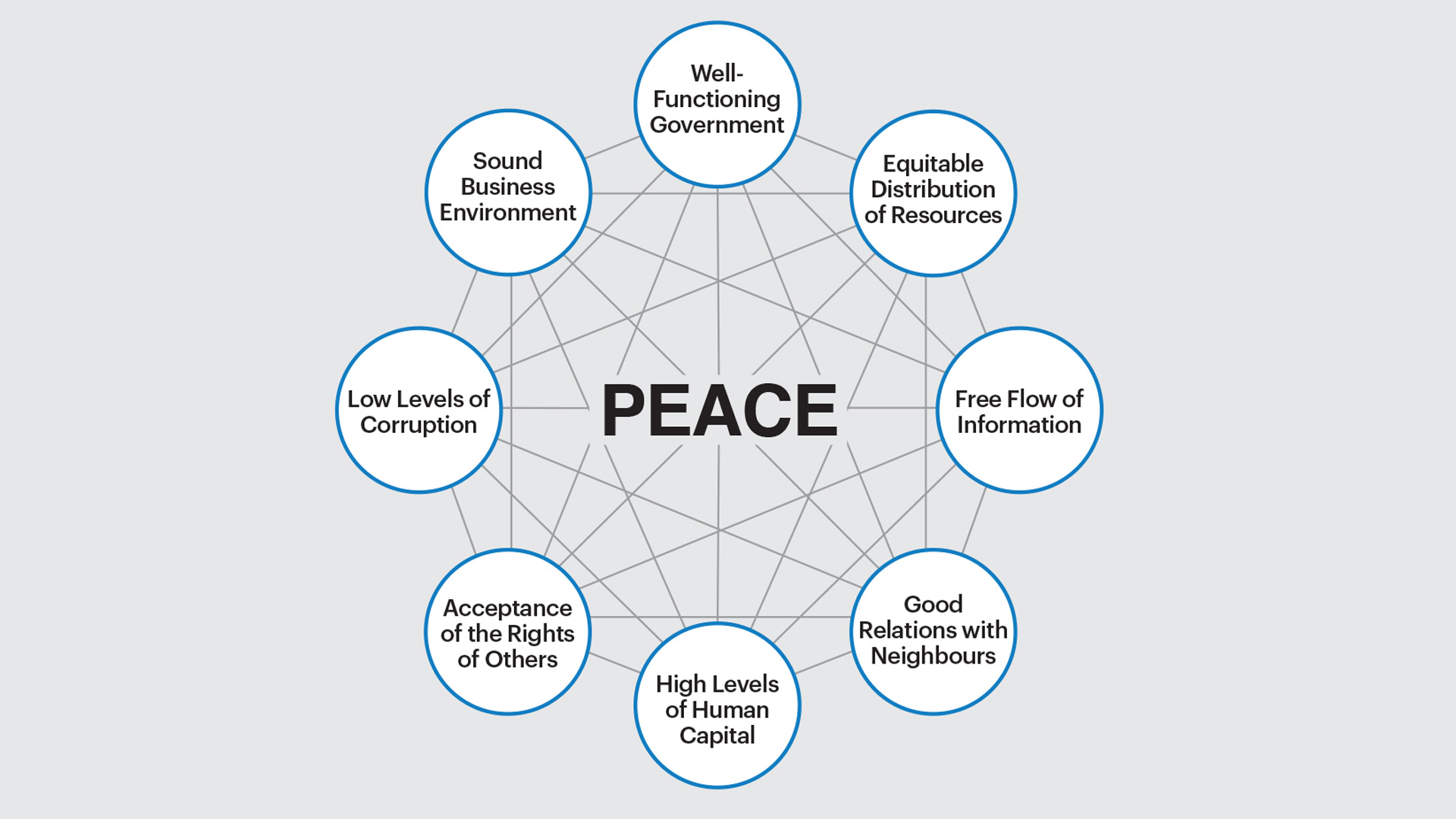The largest improvements occurred in Asia-Pacific, Russia and Eurasia, and South Asia, improving respectively by 6.4%, 6.1% and 4.2% respectively. The improvement in South Asia was mainly driven by improvements in Bhutan and Sri Lanka. The improvement in the Middle-East and North Africa was marginal. Overall, 15 of the 20 countries that comprise this region improved in Positive Peace over the period.
Positive Peace is defined as the attitudes, institutions and structures that create and sustain peaceful societies. The Index consists of eight Pillars, each containing three indicators. This provides a baseline measure of the effectiveness of a country’s capabilities to build and maintain peace. It also provides a measure for policymakers, researchers and corporations to use for effective interventions, design, monitoring and evaluation. The Pillars of Positive Peace are interconnected and are: Well-Functioning Government • Equitable Distribution of Resources • Free Flow of Information • Good Relations with Neighbours • High Levels of Human Capital • Acceptance of the Rights of Offers • Low Levels of Corruption • Sound Business Environment.

Positive Peace is a transformational concept because it shifts the focus away from the negative by describing the necessary conditions for peace and society to flourish. Due to its systemic nature, improvements in Positive Peace not only strengthen peace, but are also associated with many other desirable outcomes for society, such as higher GDP growth, better measures of wellbeing, higher levels of resilience and more harmonious societies. Most importantly, it provides a theory of social change, explaining how societies transform and evolve. Positive Peace describes an optimal environment under which human potential can flourish.
The global score for the PPI has improved by 2.4 per cent since 2009, with 126 countries improving in Positive Peace, 36 countries deteriorating and one country score being little changed. The score is calculated by taking the average country score for the 163 countries included in the index. Changes in Positive Peace generally occur slowly and may take many years for the benefits to show because institution building and changes in social norms are long-term processes. As such, global changes in the PPI Pillars happen relatively slowly, and even slight changes in global Positive Peace can be considered important.
Positive Peace has improved almost continuously since 2009, largely on the back of greater technological and economic development. The year 2015 was the only instance in which the global PPI score deteriorated, although the deterioration was small – around 0.3 per cent. That year saw a number of economic and financial crises in emerging markets (including Russia and China), which affected global economic growth. This coincided with a deep humanitarian crisis which saw large refugee inflows into Europe and North America.

All geographical regions of the world recorded improvements in their PPI scores since 2009, except North America (Figure 1.5). The largest improvements occurred in Asia-Pacific, Russia and Eurasia, and South Asia, improving respectively by 6.4 per cent, 6.1 per cent and 4.2 per cent respectively. The improvement in South Asia was mainly driven by improvements in Bhutan and Sri Lanka. The improvement in the Middle-East and North Africa was marginal.
Overall, 15 of the 20 countries that comprise this region improved in Positive Peace over the period. However, the deteriorations recorded by Libya, Syria, Yemen, Lebanon and Jordan were numerically large and almost offset the PPI gains elsewhere in the region. The only region in the world to record a deterioration in its PPI score from 2009 to 2020 was North America. At nine per cent over the period, the overall deterioration in the North American score was the sharpest movement of any region. However, this region consists only of two countries – Canada and the US – and as such, a greater variability in the average regional score is to be expected.

The COVID-19 pandemic has been and continues to be the most disruptive shock to the global society in a generation. By the end of 2021, the virus had reportedly infected over 290 million people and contributed to 5.4 million deaths. Responses to the pandemic have reduced economic activity, limited the free movement of people and changed social norms in fundamental ways.
As a measure of societal resilience, Positive Peace assesses nations’ capacity to obtain and sustain high levels of peace, as measured by the GPI. In turn, high levels of peace create a socio-economic dividend that fosters development and promotes resilience. This systemic virtuous cycle is the main mechanism through which societies thrive. Most nations operating with high levels of peacefulness will also enjoy high levels of Positive Peace.
The Positive Peace Report 2022 can be downloaded here.